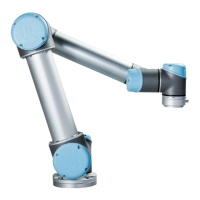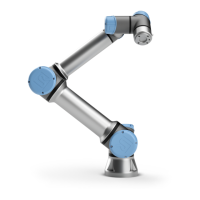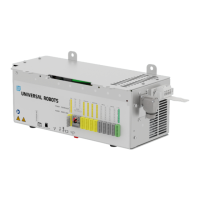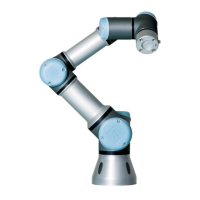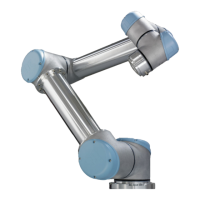2.5 Safety-related Electrical Interfaces
Max joint
speed in
normal
mode
[rad/s]
[s]
time
0.5240.024
Figure 2.2: The green area below the ramp is the allowed speeds for a joint during braking. At time 0 an
event (emergency stop or safeguard stop) is detected at the safety processor. Deceleration begins after
24 ms.
A transition to Reduced mode triggered by the reduced mode input is monitored as follows:
1. The safety system accepts both Normal and Reduced mode limit sets for 500 ms after the
reduced mode input is triggered.
2. After 500 ms, only the Reduced mode limits are in effect.
If any of the above properties are not satisfied, the safety system issues a Stop Category 0.
A Stop Category 0 is performed by the safety system with the performance described in the
following table. The worst-case reaction time is the time to stop and to de-energize (discharge to
an electrical potential below 7.3 V) a robot running at full speed and payload.
Worst Case
Safety Input Function Detection
Time
De-energizing
Time
Reaction
Time
Robot Emergency Stop 250 ms 1000 ms 1250 ms
Emergency Stop Button 250 ms 1000 ms 1250 ms
System Emergency Stop 250 ms 1000 ms 1250 ms
Safeguard Stop 250 ms 1000 ms 1250 ms
2.5.2 Safety-related Electrical Outputs
The table below gives an overview of the safety-related electrical outputs:
Safety Output Description
System Emergency Stop Logic low when the Robot emergency stop input is logic
low or the Emergency stop button is pressed.
Robot Moving While this signal is logic high, no single joint of the
robot arm moves more than 0.1 rad.
Robot Not Stopping Logic high when the robot is stopped or in the pro-
cess of stopping due to an emergency stop or safeguard
stop. Otherwise it will be logic low.
Reduced Mode Logic low when the safety system is in Reduced mode.
Not Reduced Mode The Reduced mode output negated.
UR5/e-Series I-16 Version 3.11
Copyright © 2009–2019 by Universal Robots A/S. All rights reserved.
